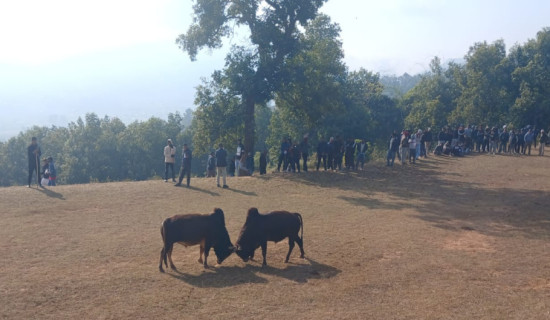- Thursday, 1 January 2026
Treading Forked Geopolitical Paths
The return of geopolitics affirms the weight of political realism where all states seek to survive and endure under global disorder by capitalising on their power relative to other states and maximising security. An understanding about the changing nature of geopolitics is central to knowing the world geostrategic frame on which foreign policy of a state operates. Its destiny is shaped and articulated in an adaptation to a hierarchy of powers of a multi-polar system. The range and strength of their interactions underline the contours, nature and conduct of national leaders. Wise leaders set national priorities and carefully make distinctions among the nation’s varied interests to ward off crises spilling into the national space, keep the constitutional order robust and balance nationalistic ambition and global obligations.
The gain, however, rests on the wisdom of leaders to navigate the state into multi-verse without incurring losses to self and know what its great powers perceive as its foreign policy course and devise their ensuing response. The Kautilyan geopolitical lesson beyond the canons of the Westphalian frame is very insightful. As a political realist outside the Atlantic scholarship, his geopolitical dictum entails to manage careful ties with the neighbours so that no one dictates its course and balances the interest of outside powers. His advice to the emperor Chandragupta is virtuous like Prithvi Narayan Shah’s wise counsel to his successors. Even Jung Bahadur Rana suggested the courtiers to respect local codes and manage local commons for the interest of people thus giving them an opportunity for self-development so that they are loyal to the state.
The linkage
The linkage of knowledge to interest, power, ideology and legitimacy is not new in world politics. The relativism of geopolitical theories, however, refuses certain aspects of locally evolved universal wisdom and its pattern of international relations. One example is tributary ties of small neighbours with the celestial Chinese empire. The other is Ashoka’s empire in the Indian subcontinent. Nepal’s self-evolution as an independent state between the two and adaptation during the era of imperial, colonial and state system can serve as a guide for its modern foreign policy conduct. It tells the government to decide its own policies, not dictated by the terms of aid, advice, investment and trade. Modern technology is eroding the iron rules of geography but not opening fully to the law-based order for states to cooperate in functional areas.
Geopolitics is a power-driven game devoid of normative gaze. Now it has acquired a broader meaning, a weltanschauung, a wide-ranging worldview and the place of people within it waiting to be regulated by Hugo Grotius’s account of global norms, laws and institutions favourable to the dignity of even small states like Nepal. Modern geopolitics imbibes the bases of state power and its configurations in the global space for self-defence, security and prosperity. They impinge on the behaviour of states and leaders’ struggle for justice, legitimacy and peace. It retains a certain legacy of Cardinal Richelieu’s grand strategy of raison d’ etat of state politics in its anti-moralist and anti-legalist outfit and refuses the civic norms, laws and conventions mutually agreed for peaceful coexistence and remain coefficient.
It is rooted in its autonomous capacity (not religious or class morality) of the state to pursue national interests, avert any crisis, adapt to an interconnected world and provide essential goods and services for its people for stability and progress. In geopolitics, skill, expertise, foresight and strength outweigh law and ethics. In this sense, the state’s reason for existence is justified in defending its own account of the national way of life. This is well articulated in Dibya Upadesh of Prithvi Narayan Shah. Neo-realist professor of international relations John J. Mearsheimer argues, “The keys to war and peace lie more in the structure of the international system than in the nature of the individual states.”
This means lackadaisical handling of geopolitics in a state of global volatility and power shifts subverts internal cohesion of state and unbinds the constellation of polity, economy and people in national space already pummelled by globalisation. Its process has decoupled the economy from democracy and denationalised national capital and labour. This view affirms the above remarks that foreign policy is not an extension of domestic policy. Internal peace does not mean a peaceful world. Nepali state must be able to coordinate antagonistic forces to avert external powers' entanglements in its domestic power struggle. Geopolitics sets the link between a nation’s geography and its strategy to organise the state’s spaces.
The first is the heartland-capital city, Kathmandu, which is a decision-making centre. It specialises in politics to manage ecological, social, cultural and economic spheres, security and foreign policy for national sovereignty, survival and independence. The second is strategic zones central to defend and consolidate the heartland’s imperatives for progress and mobilise centripetal forces of society and resources for promoting national unity, progress and vital national interests. The third is buffer regions that control and neutralise the adverse cultural and ideological influence flowing from outside and manage resources so that the Nepali state can keep its major interests and historical, cultural and linguistic memory and national identity.
Fourth is the nature of frontiers whose management is essential to protect and promote the peripheral interests of the state. This shows that the proper organization of the nation’s various geographical spaces is a vital strategy of internal stability and foreign policy of pro-active nonalignment. Professor Peter J. Taylor rightly argues, “Frontier is outward-oriented and boundary is inward-oriented” adding that “boundaries are the necessary components of sovereignty of territories” and that “sovereignty must be bounded: a world of sovereign states is a world divided by boundaries.”
Nepal’s non-alignment is an ideal construction of foreign policy based on the principles of Panchsheel, the philosophy of Buddha. Its non-alignment is narrowly defined by restricting Nepal’s entry into military alliance but deem Gorkha recruitment and strategic partnership a symbol of friendship. It underlies the geopolitical necessity of survival between the protagonist powers, urgency to evade great powers’ competition to influence it, moral imperative to promote native values of golden mean and economic and political awakening about the need to diversify international relations beyond geographical determinism. Jumping on the bandwagon of global politics without building enough trust with neighbours can, however, easily fork national politics and drain its internal strength.
Its oscillating policy on the rival initiatives of neighbours and the USA in the nation cannot make its nonalignment stout and sparkling. Two critical risks are in the offing: first, utilisation of external support for internal regime or government change has institutionalised foreign interests in national politics, and second, contradictory position of the same party in the government and in opposition thus fostering inconsistency in foreign policy. It does not create credibility of leaders and creditworthiness of the nation. Public awareness of foreign affairs has increased.
The political worth of ideological proximity to India and the West marks a certain distance from China which immunes it from the irritations in bilateral ties. China finds Nepali state is weak and heavily permeated by internal interest groups and external forces through their soft power approach. China too, like the USA, speaks about Nepali sovereignty. Nepal, however, never remained far off from the gift of the Chinese civilisation, cultural exchanges and connectivity. Like India and the West, China now is interacting with many layers of Nepali society, not just the state-to-state and party-to-party relations.
Now four issues have added Nepal’s geostrategic value aside from its geographic pivot and attracted the USA: endorsement of MCC and quasi execution of State Partnership Programme, participation in its democratic fraternity, official position in Venezuela and criticism of Russian invasion of Ukraine. In the later two issues it departed from the policies of both neighbours’ muted response. During her visit, US Deputy Secretary Victoria Jane Nuland made a sensible remark “Nepal should keep vigil in the protection of its sovereignty.”
Nepal and India also participated in the global democratic summit organised by the US in defence of liberal order. Nepal’s constitutional, economic, political and educational systems are designed in the image of the policies of India and the West. Unlike India, however, Nepal is not a member of the QUAD and Indo-Pacific Strategy led by the USA despite the latter's lure. The former has always aspired to acquire global power status either by acquired muscle or on its own strength and indulging in China’s checkmate scheme; Nepal has a vaunted policy of not allowing its territory to be used by external powers against Chinese security interests even showed sensitivity to Indian willingness to set up a Buddhist college in Mustang.
Despite opposition from India and the USA, Nepal joined the Belt and Road Initiative of China, undertook few projects under it and executed food security, poverty alleviation and epidemic control and reconstruction in remote areas under Global Development Initiative. Former President Bidya Bhandari participated in the webinar of the Global Security Initiative aimed to release what China calls positive energy for world peace and development. China has successfully mediated the conflict between Saudi Arabia and Iran and both sides agreed to open diplomatic relations and made efforts to broker a ceasefire in Ukraine. Unlike Russia-US relations, China’s ties with the USA, India and Russia are not mutually exclusive. Yet, their stalemated position has lent small states room for manoeuvre.
Nonalignment
In a multi-polar world of disorder, Nepali diplomacy must capture the utility of diverse actors beyond trinity of India, China and the USA and plan a scenario of real geopolitical trends affecting it especially Sino-Indian competition and conflict which disposed it to low key participation in Raisina Dialogue and Boao Forum for Asia, Indian interest in the US’s China containment strategy and US-China competition in Nepal, possible evolution of nonalignment in the future and conceivable shape of the global order to emerge. Great power competition for reasons of its strategic geography can offer it leverage if managed well Nonaligned movement is lawful, not lawless like geopolitics, the former is based on solidarity while the latter on subordination.
The course of geopolitics is oriented to power struggle while the struggle of nonalignment is towards a vigilant sense of justice, mutual cooperation and peace. Its strategy is optimisation of interests in the golden mean. Nepal’s crucial virtues relative to other powers' interest and will are the claims for sovereign equality, autonomy in foreign policy, freedom of manoeuvre and alignment of the doctrine of non-alignment in practice. It is here the role of scholars in conceptualisation of foreign policy is important for Nepal so that it can evade ambiguity.
(Former Reader at the Department of Political Science, TU, Dahal writes on political and social issues.)
















